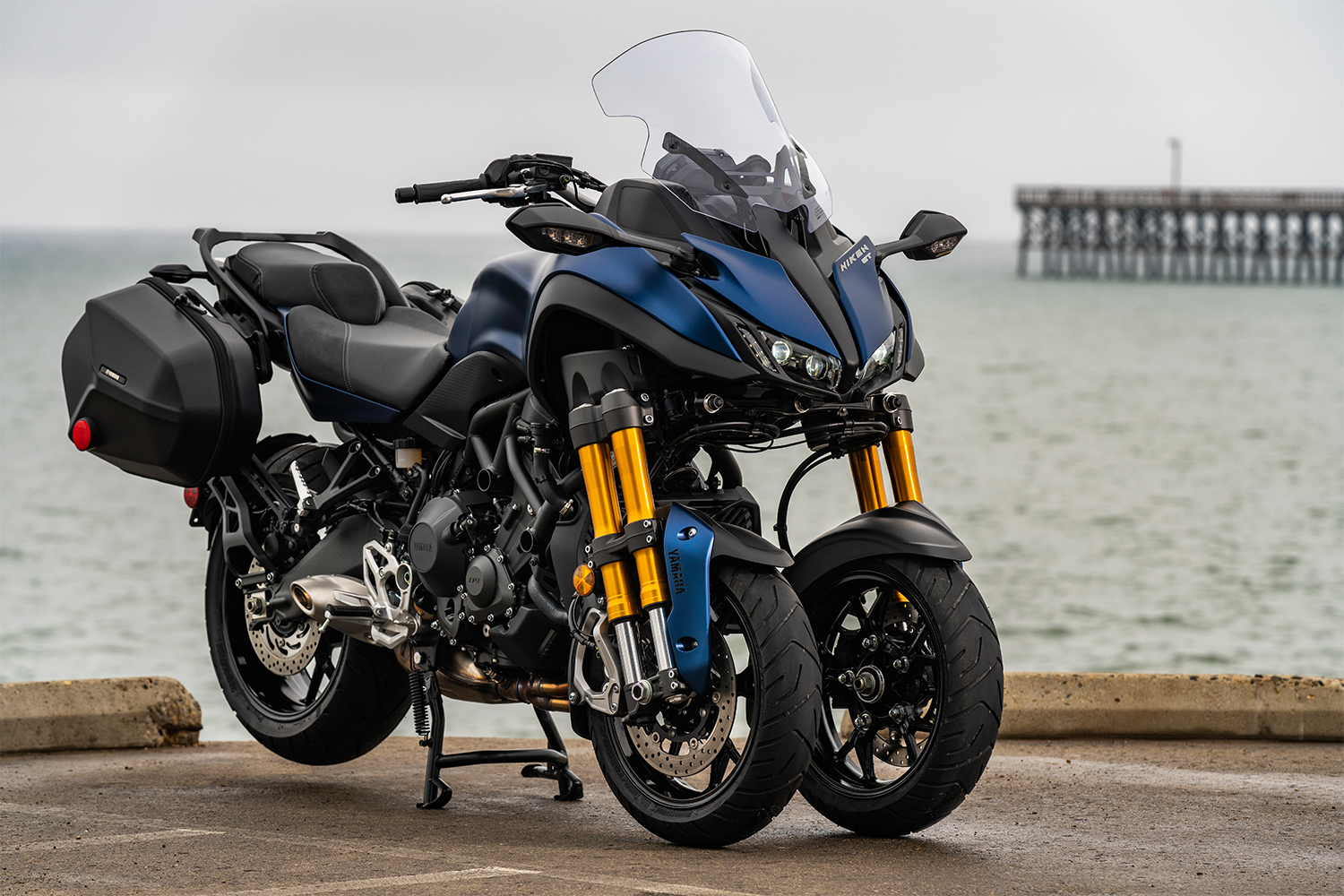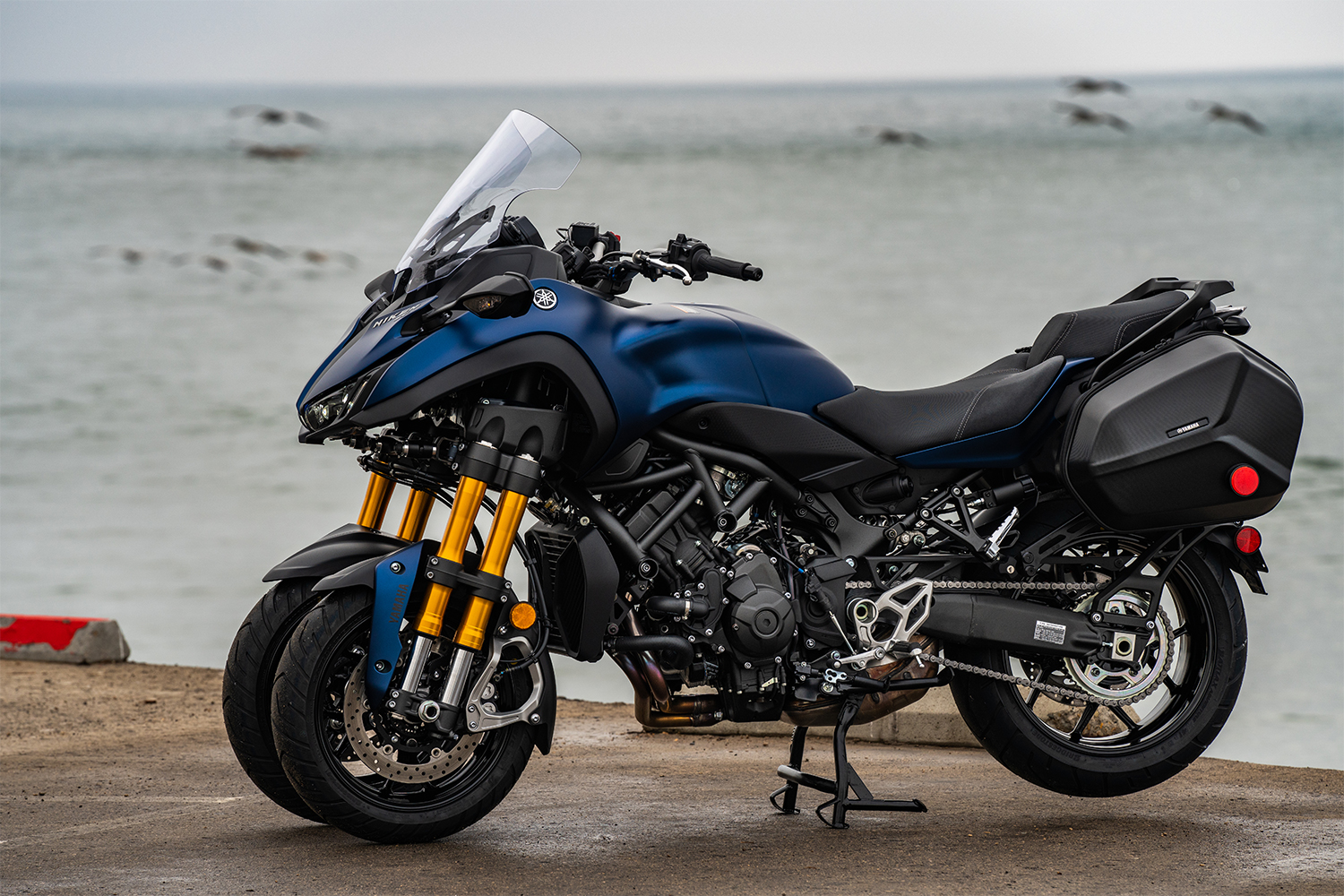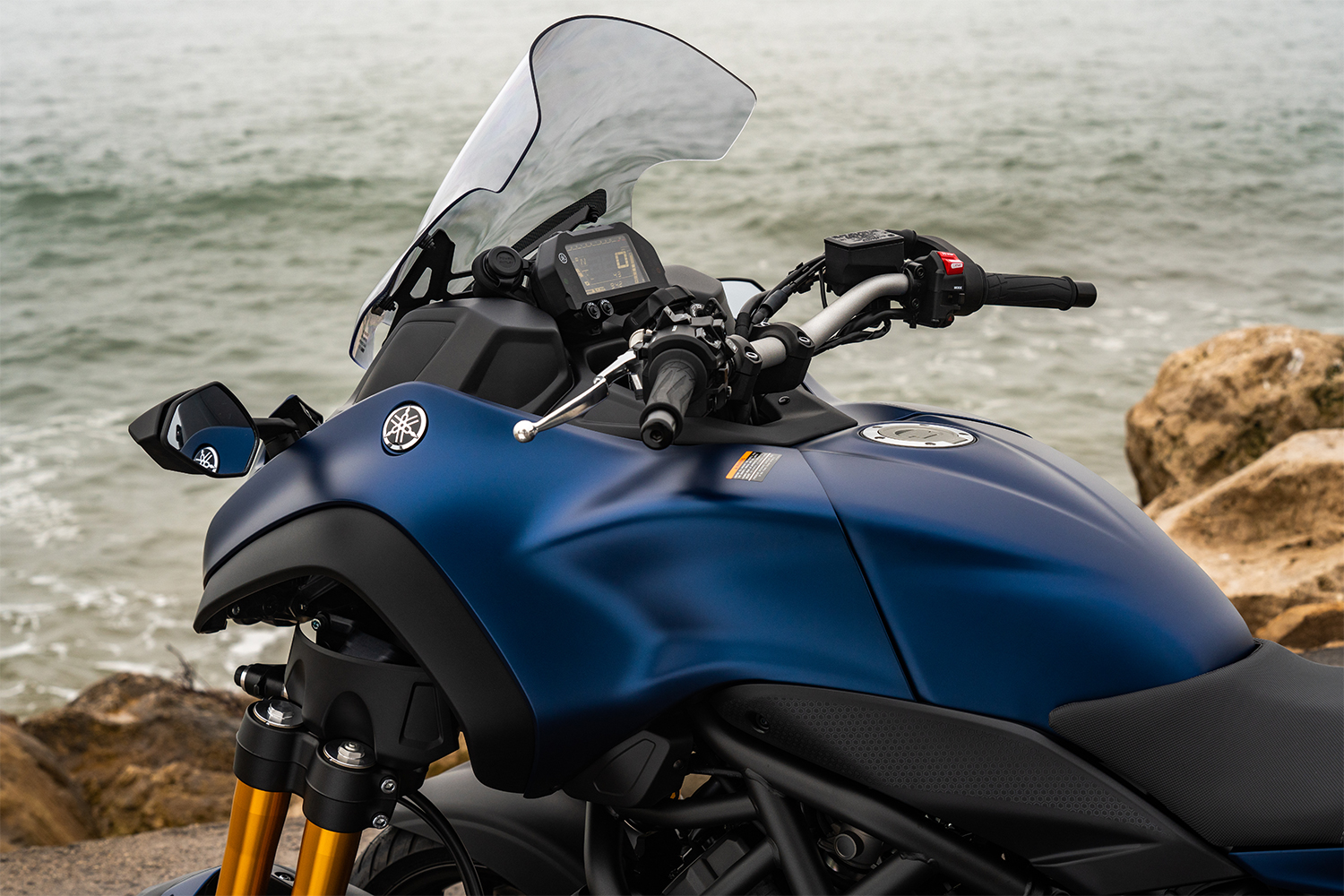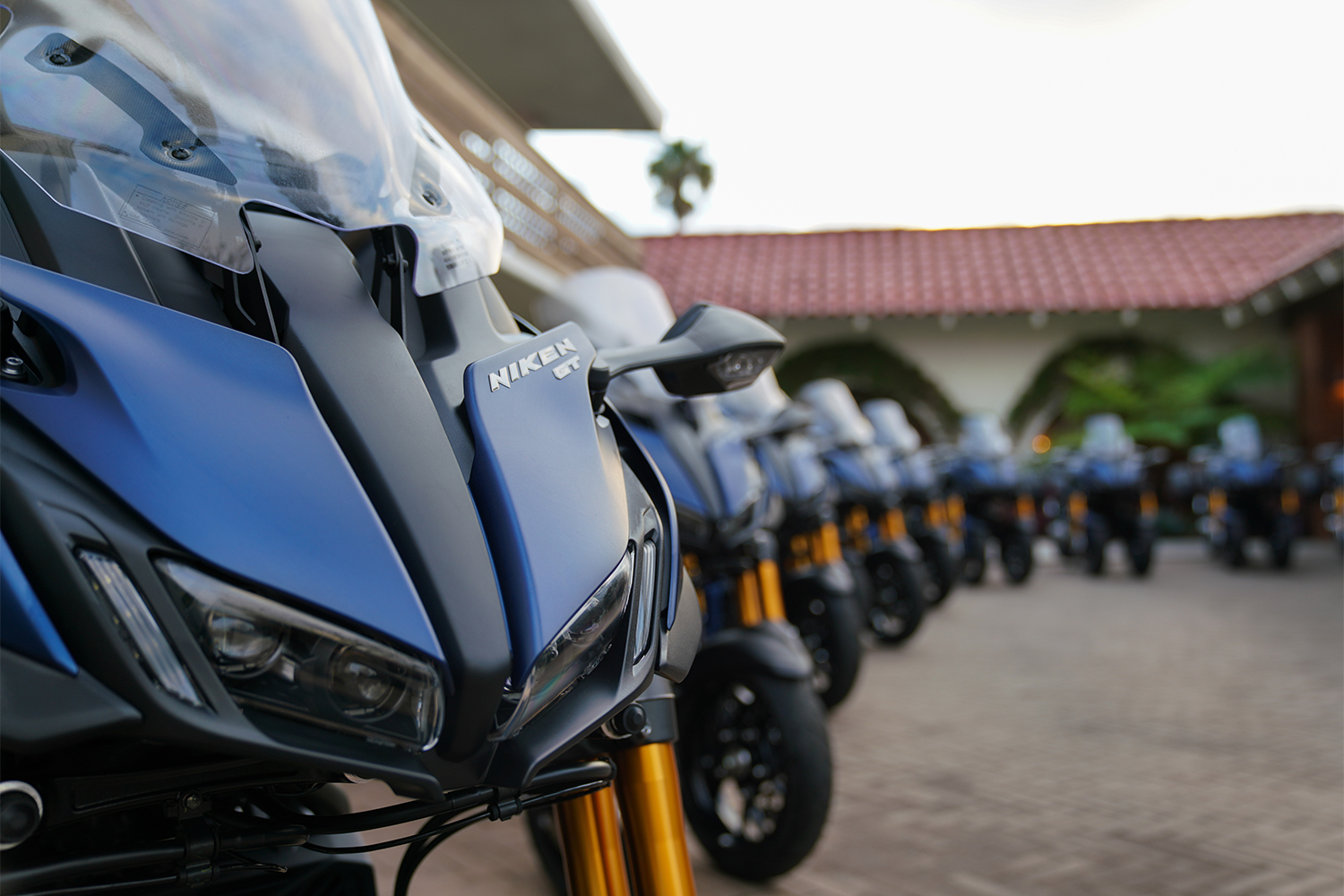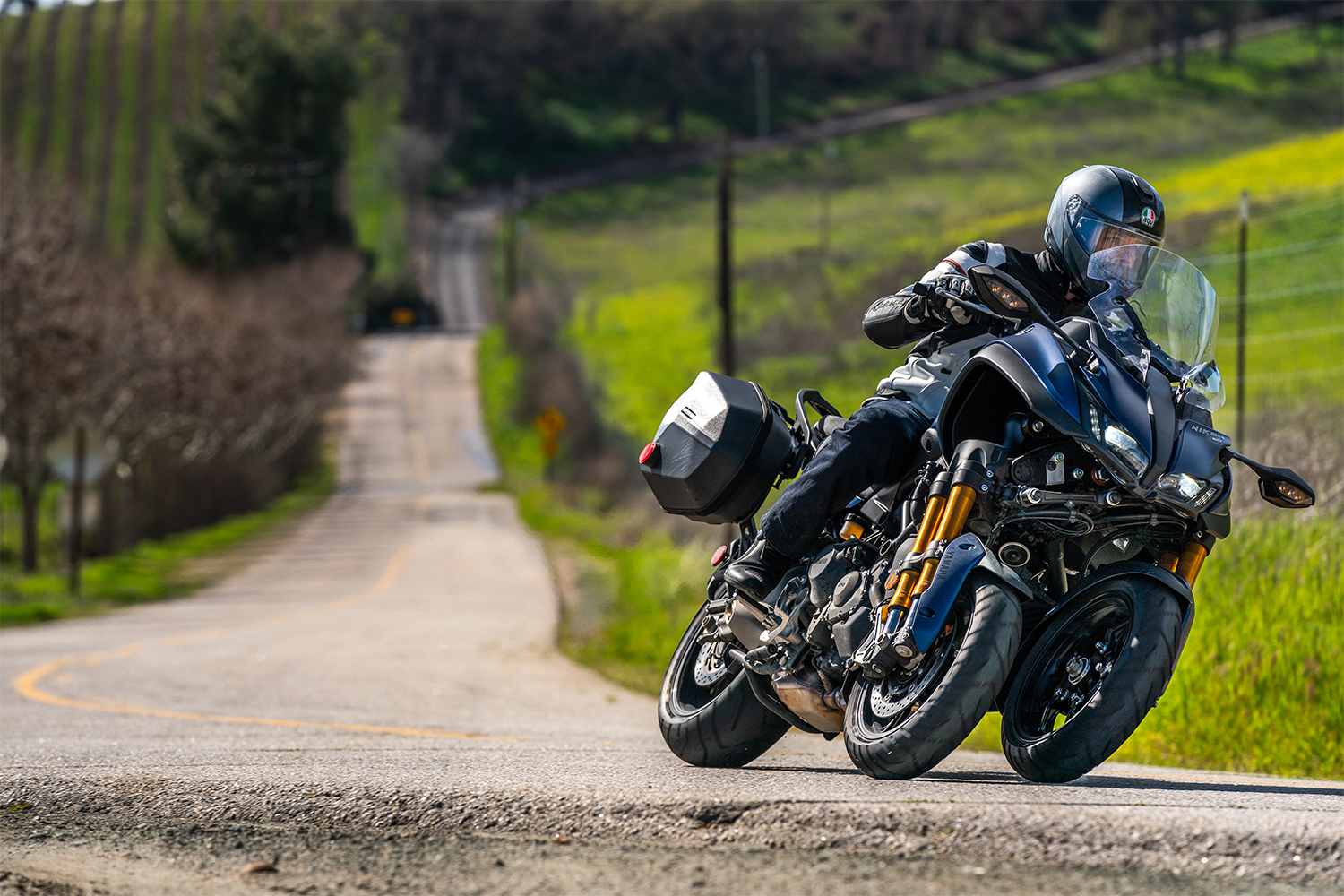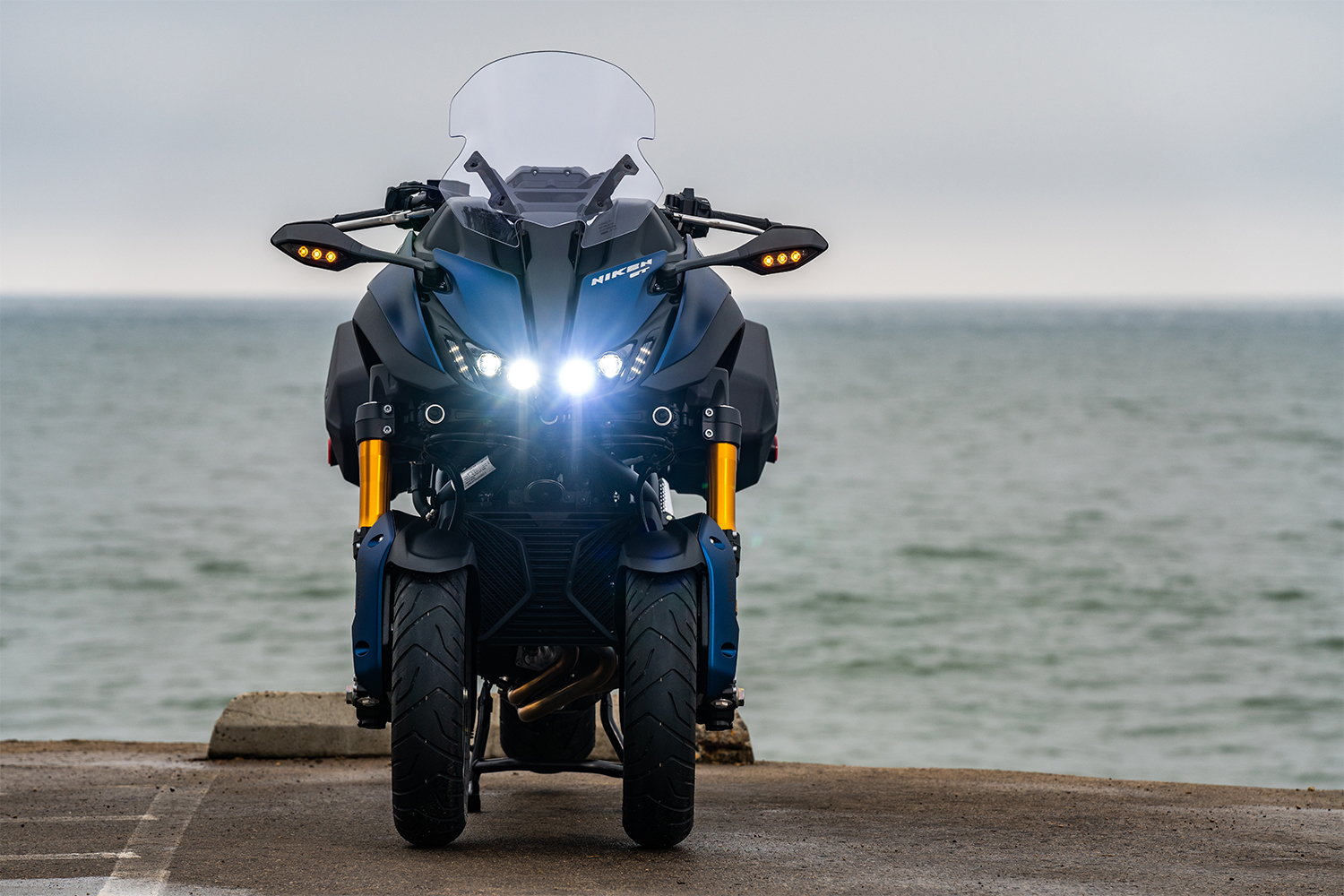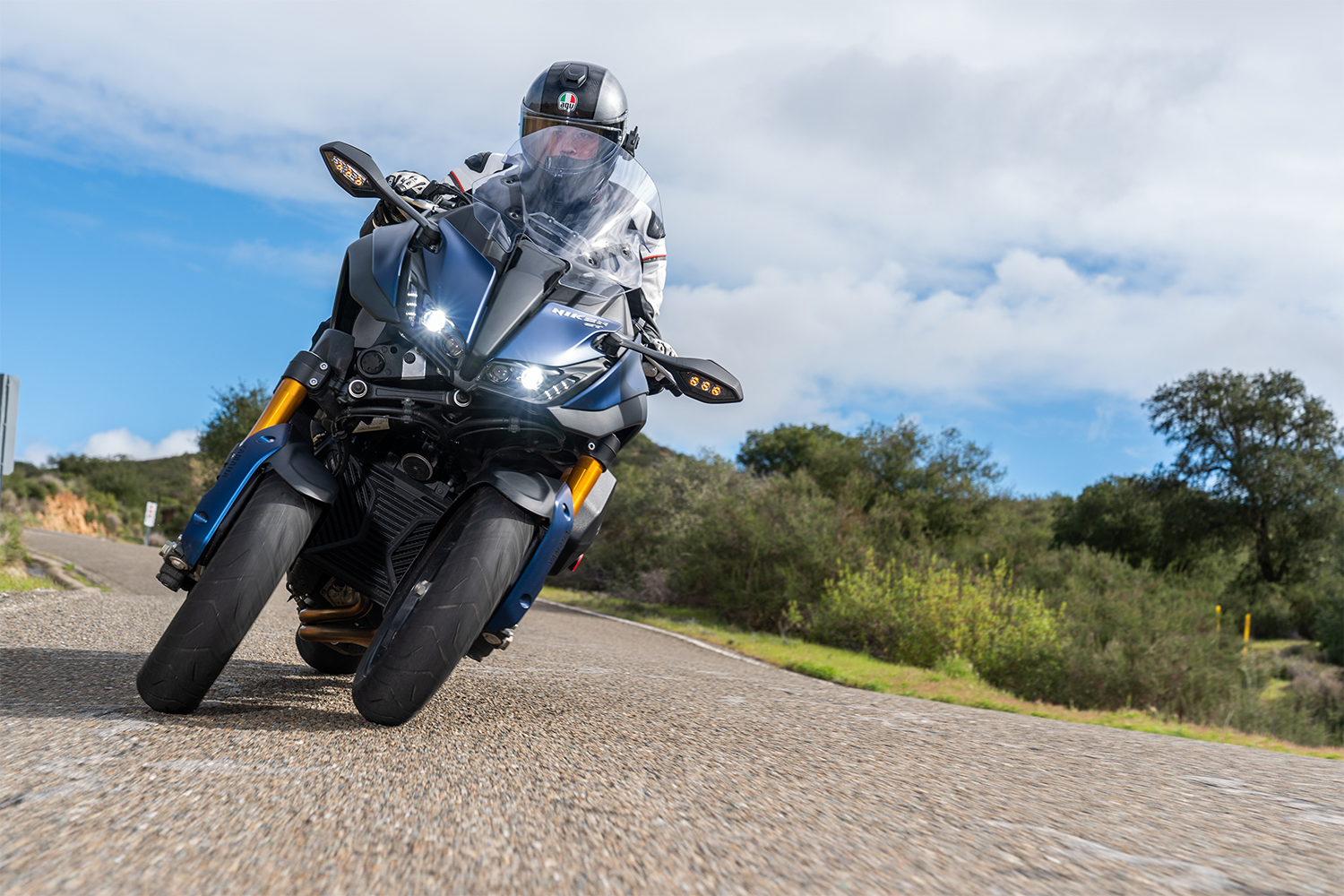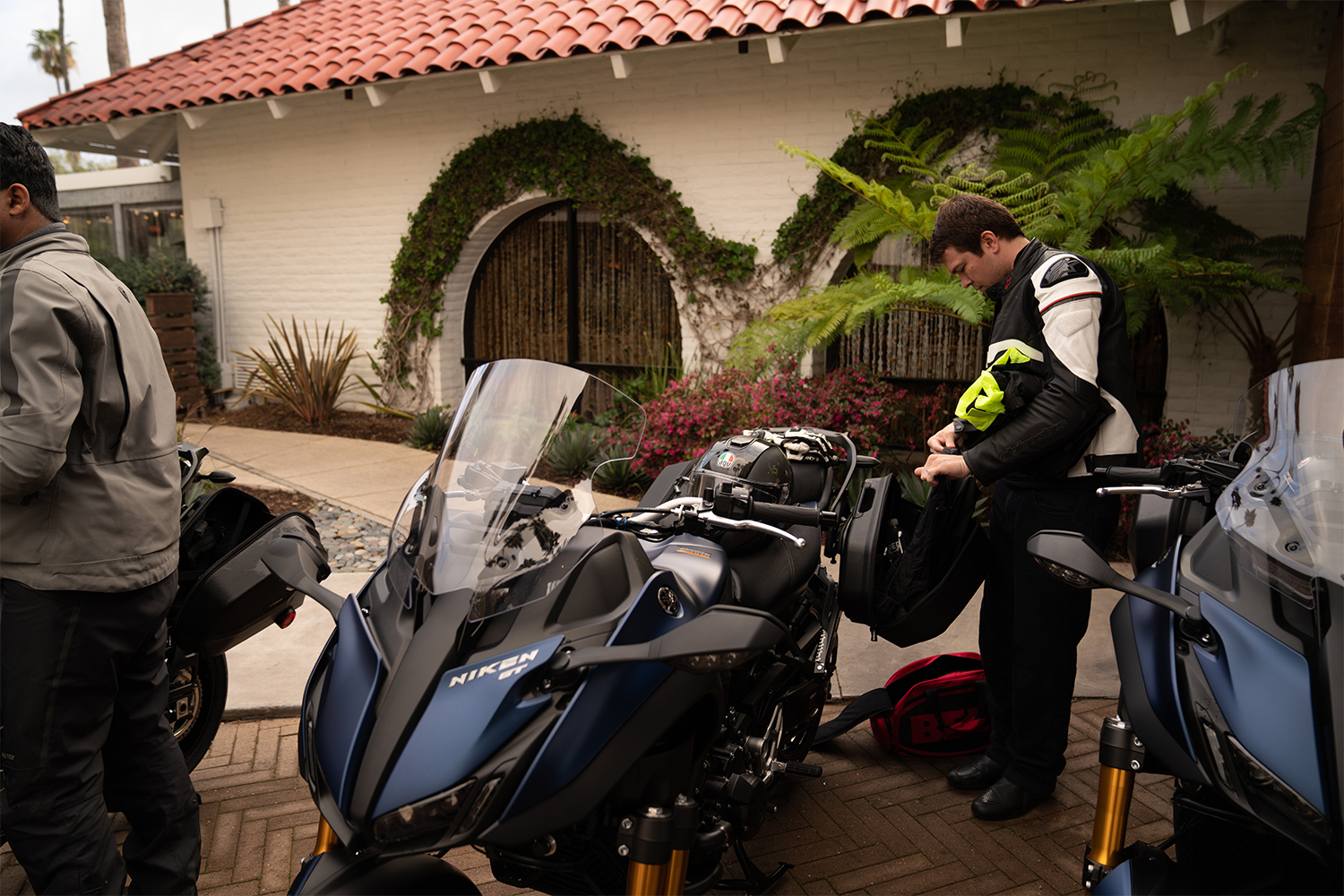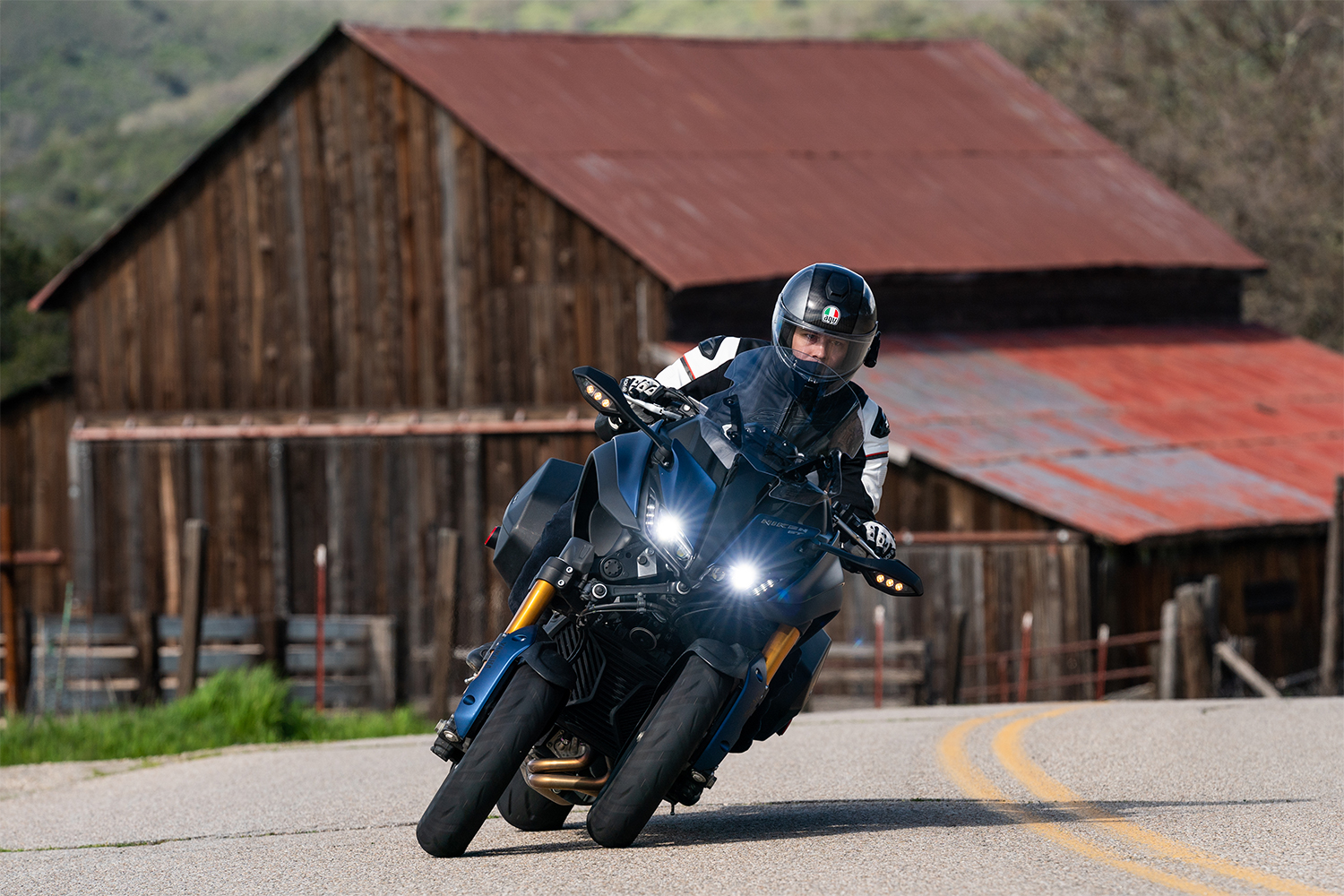Regardless of style, speed or attitude, the one thing that all motorcyclists have in common is the need to keep the rubber side down, i.e., not crash. Flirting with a pastime that some deem too risky can be part of the appeal, but what makes for a truly exceptional riding experience is not just the joy of the ride, but the glory of returning home knowing you and your machine were able to maneuver the pitfalls of the asphalt jungle.
In an effort to bring more riders home safely, the world of motorcycles has been on fire for the last decade with the adoption of safety-related technology. From cornering ABS to traction control to tire technology, motorcycles today are significantly better at handling hazards than they were 20 years ago. But few manufacturers have been so bold as to throw another wheel on the front of one of their bikes. So when Yamaha asked if we’d like to roam around the California coastline on the wild, 3-wheeled Niken GT, we jumped at the chance.
Hitting the road
To give us a good smattering of weather conditions and road types, we started our journey in Goleta, CA and rode up to Paso Robles, then did the same route in reverse over the course of two days, winding through everything from single-lane back roads to interstate highways. In all, we rode a little under 400 miles to put the Niken GT through its paces.
A monstrous mechanical marvel
Before we could don our helmets and gear, we needed to figure out just what it was that we’d be riding.
The Niken GT is classified as a “sport tourer.” This means plenty of power and ability to handle corners at higher speeds, but with added conveniences like saddle bags, cruise control, and blazing hot heated grips. The Niken GT carries over a lot of similarities from Yamaha’s Tracer 900 GT, but what obviously sets the Niken GT apart from other sport tourers is Yamaha’s Leaning Multi-Wheel system (LMW).
The LMW is essentially two sets of forks that are mated to Yamaha’s parallelogram linkage. The parallelogram linkage is made up of two parallelogram arms and a steering tie rod that connects the steering heads coming off the forks. Confused yet? It gets better.
Yamaha’s mechanical wizardry that allows a 3-wheeled bike to lean and turn just like a traditional two-wheeler.
The parallelogram linkage then gets connected back to frame, while the steering tie rod gets connected back to the head tube that allows the rider to steer the wheels. The ability to let the steering (through the tie rods) and leaning (through the parallelogram arms) work independently but also in conjunction is where the magic happens.
Thanks to a principle known as Ackermann geometry, the LMW makes it possible for the front wheels of the bike to track two different radiuses. In the simplest possible terms, it’s the mechanical wizardry that allows a 3-wheeled bike to lean and turn just like a traditional two-wheeler does.
A fresh take on an old idea
It’s true that there are other variations of three-wheel motorcycles out there, like Piaggio’s MP3 and Can-Am’s Spyder, but neither of these give you the lean angle that the Niken GT does. Having the ability to lean and ride with all the same principles as a standard motorcycle makes the transition from two wheels to three absolutely seamless, with the added benefit of additional traction — or so we were told.
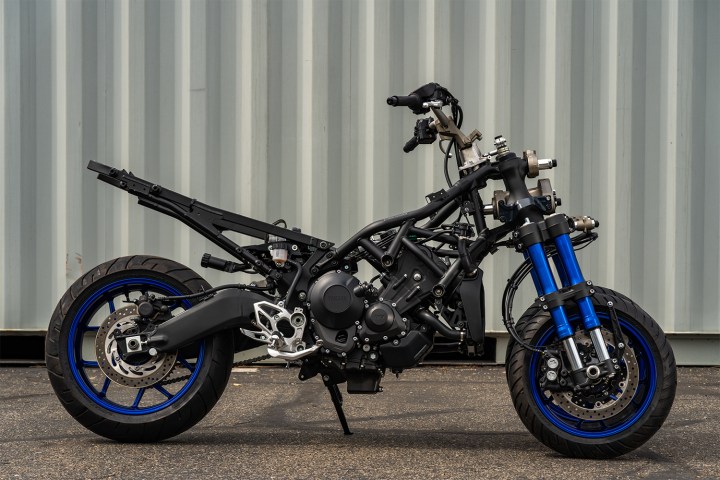
The downfall of all of that wonderful leaning wizardry is that, unlike the other three-wheelers on the market, the Niken GT doesn’t stand up on its own. It’s truly like a motorcycle in that if you push it, it’ll fall over. This comes as a surprise to most, because it’s not what we’re used to. There’s a reason you start out on a tricycle before graduating to your first two-wheeler—a trike is stable. So it’s best to not think of the Niken GT as a trike, and instead think of it as an evolutionary jump in what a standard motorcycle can be.
Stepping into the cockpit
Ready to experience motorcycle evolution first-hand, we hopped on our three-wheeled steed and headed for the open (and very wet) road. Greeting us was a set of semi-rigid saddlebags with dry bags inside, a centerstand, a taller windscreen and thicker seat compared to the standard Niken, heated grips and two 12 volt 1 amp outlets for electronics.
The dash provides all the necessary information, including access to three ride modes that temper throttle response as well as three traction control levels, with the ability to turn TC off. On the grips are selectors for setting cruise control, as well as heated grips (did we mention they get crazy hot?). Not as easily identifiable are the quick shifter, slipper clutch and ABS—all standard.
Then there’s the motor, Yamaha’s glorious 847cc inline three-cylinder that’s been tuned specifically for the Niken. Yes, it will do wheelies. All in all, the Niken GT is certainly well-equipped.
Ripping up some road
Once on the highway, we started looking for ways to upset the bike. Yamaha claims that this motorized monster is meant to improve on the traditional motorcycle’s ability to handle unsavory conditions — so naturally the best way to test that is to ride as rough as possible. Aiming for potholes, changes in the asphalt, and rain grooves is normally not a test you want to try while doing freeway speeds on a brand new bike, but the Niken GT didn’t blink at our attempts to upset it. At the very least we expected a slight twitch of the handlebars, but instead we were met with smooth composure.
We expected a slight twitch of the handlebars, but instead we were met with smooth composure.
Once we got off the highway, the rain really started to pick up. From slight drizzle to downpour, we started putting our trust into those two front wheels when barreling into wet corners with reckless abandon. Normally these types of situations would have us white-knuckling, but thankfully they were a breeze, even when we did start to lose grip up front.
When your front end starts to slip, it normally does one of two things: it slips only momentarily and then grips again, which puts the tires out of alignment and makes the bike jerk in the opposite direction you want to go; or it slips a lot and you fold the front end, which results in a “low-side” crash. With the Niken GT we were slipping the front end due to speeds normally reserved for dry days, but the sensation wasn’t jarring. The slip was subtle, and we could feel the LMW suspension doing its job. This meant the second front wheel was taking over traction duties and allowing for a smooth ride that was still on the trajectory we intended.
A little water never hurt anybody
Back on the highway the rain didn’t stop, and with more “flooding” signs posted than we care to remember, it was another situation that would normally have us concerned about traction. We were once again pleasantly surprised by the composure the Niken GT showed. Instead of frying our nerves with second-by-second decisions on how best to negotiate a water crossing, the Niken GT cleanly cut through everything from modest puddles to heavy downpours, giving credence to its name, Niken, which means “two blades.”
On day two, the majority of the rain had cleared and we finally had some time to unleash all 847ccs and rail this sport tourer through the SoCal hills. With a 45 degree max lean angle, the Niken GT does have its limits. With that said, 45 degrees is more than enough to put a grin on your face while blasting through your favorite back roads. And with all that extra traction up front, the gravel or sand that gets kicked up in corners is much less concerning, allowing you to enjoy the road more and worry less.

The only downside to the Niken GT’s extremely composed front end is the sacrifice you make for precision. One of the best parts about a sport bike is the direct connection with the road that a set of clip-on handlebars provides. With so few parts between your hands and the wheel, a rider is blessed with near-instant feedback of the condition of the road. With the Niken GT, all the linkage points and well-sorted forks provide an exceptionally smooth ride, but they do limit feedback. So much so that even when pulling off the shoulder of a highway into a gravel turnout the LMW was shifting and moving, but we wouldn’t feel it. On the upside, the bike doesn’t get jerked around when you hit a bad spot in the road. On the downside, you lose some of that razor sharp accuracy that a single-wheeled front end provides.
But it’s those comparisons that make the Niken GT so impressive. As our group of journalists gathered at each stop, evaluations were made and it quickly became clear that the high speeds at which we were able to take corners (fraught with slippery hazards) had us comparing the Niken GT’s handling with that of sport bikes, not other sport tourers. If that isn’t an endorsement of the Niken GT’s ability, we don’t know what is.
But why?
Once we finished up our ride, to say we were impressed with the Niken GT’s capabilities is an understatement. Even when we found the edge of its traction, the drop off wasn’t a cliff like most motorcycles. Instead we found a gradual slope that was easy to maneuver, keeping us out of harm’s way.
The Niken GT elicits emotion, and that’s the mark of something special.
So what does the LMW technology mean and who is it for? Have we found the unexpected pinnacle of motorcycles? Like most things our answer is “it depends.”
The Niken GT is a big bike and rides like a big bike, so beginners beware. That said, if you’ve spent even a modest amount of time on a motorcycle, the additional traction and extremely composed ride will have you jumping for joy if road hazards are a daily occurrence.
If you’re a commuter, especially in wet weather, and the Niken GT saves you from going down even once, it’s well worth the $17,299 price tag. If you live somewhere with only a small amount of rainfall, you’re going to miss out on a lot of what the Niken GT’s wet road prowess has to offer. You won’t be disappointed with its performance, but you’ll definitely miss out on what makes the Niken GT special.
If you’re a daily commuter who lives in a wetter area of the world, the Niken GT is the bike of your dreams — as long as you enjoy the looks. There’s a common saying that if you don’t look back at your bike after a ride, then you bought the wrong bike. The Niken GT is a looker, but not in the traditional sense. The engineering masterpiece that is the front end will have passersby gawking, and inevitably make purists scoff as you zip past. Either way, the Niken GT elicits emotion, and that’s the mark of something special.
Yamaha has taken a huge step in creating something that helps motorcyclists deal with the biggest issue both new and experienced riders face, keeping the rubber side down. Regardless of where you come out on the looks, price tag or features, not ending up in the weeds is always the goal and the Niken GT makes that a whole lot easier.
